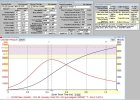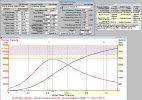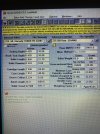ShtrRdy
Well-Known Member
I've used Quickload for several years and use to think I was getting reasonable results from the simulation. It seems that after I bought an update to the component files the results I get now are way off.
Since I've most recently been working with the 22-250 Rem I thought I would load up a few rounds at two different charge weights and measure the velocity with the Magnetospeed. When I got home I measured the water weight capacity of three cases that were fired and measured the case length.
Some of the entries to Quickload are:
22-250 Remington
COAL = 2.457"
Bullet length = 0.870" ( Hornady 60 gr V-max)
Barrel Length = 23.622" (Tikka 600mm)
Fired case H20 capacity = 45.9 grain
Fired case length = 1.910"
Powder used = Hodgdon Varget
For starters, the measured velocity is 184 fps faster than the simulated velocity when using 34.0 grain of Varget. When using 35.0 gr Varget the measured velocity is 167 fps faster than the simulated velocity.
Simulated Measured difference
34 gr Varget 3295 fps 3479 fps 184 fps
35 gr Varget 3383 fps 3550 fps 167 fps
The following is a screen shot of the simulation while the weighting factor is nominal = 0.5

I tried changing the Weighting Value and am comfused as to what I am seeing. When I increase the Weighting Value the peak pressure goes up but the muzzle velocity goes down.

If someone has some spare time would you mind running a simulation on your version of Quickload to see if it comes up with the same answer? My version of Quickload is v3.6 and using the Data Update from July 2021.
Since I've most recently been working with the 22-250 Rem I thought I would load up a few rounds at two different charge weights and measure the velocity with the Magnetospeed. When I got home I measured the water weight capacity of three cases that were fired and measured the case length.
Some of the entries to Quickload are:
22-250 Remington
COAL = 2.457"
Bullet length = 0.870" ( Hornady 60 gr V-max)
Barrel Length = 23.622" (Tikka 600mm)
Fired case H20 capacity = 45.9 grain
Fired case length = 1.910"
Powder used = Hodgdon Varget
For starters, the measured velocity is 184 fps faster than the simulated velocity when using 34.0 grain of Varget. When using 35.0 gr Varget the measured velocity is 167 fps faster than the simulated velocity.
Simulated Measured difference
34 gr Varget 3295 fps 3479 fps 184 fps
35 gr Varget 3383 fps 3550 fps 167 fps
The following is a screen shot of the simulation while the weighting factor is nominal = 0.5

I tried changing the Weighting Value and am comfused as to what I am seeing. When I increase the Weighting Value the peak pressure goes up but the muzzle velocity goes down.

If someone has some spare time would you mind running a simulation on your version of Quickload to see if it comes up with the same answer? My version of Quickload is v3.6 and using the Data Update from July 2021.

